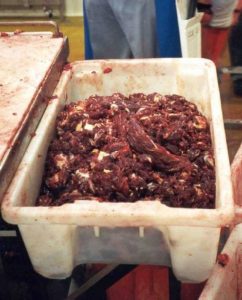Cleaning, sanitation and housekeeping
What is good housekeeping?
Housekeeping is the practice of ‘cleaning as you go’. Continually cleaning up is the best way of reducing the likelihood of contamination.
Good housekeeping means we remove fat, meat scraps and blood from the work area and amenities on a regular basis. Fat, meat and blood are a food supply for the bacteria. Fat and meat scraps should be put in the correct tubs and chutes.
Inedible product must be kept separate from edible product and is usually stored in red tubs.

Inedible product is usually stored in red bins
Edible trimmings and off-cuts are stored in white tubs in boning rooms and on slaughter floors. These tubs must be kept on stands off the floor to minimise the possibility of accidental contamination.

Edible product is usually stored in white bins
Water on the floor and work surfaces is also a source of potential contamination. Bacteria like Salmonella and E.Coli breed in water and this can contaminate the product. Work surfaces must be kept dry and water lying in pools should be swept or pushed into drains.
All tools, equipment and spare parts should be put away when not in use. Hoses should always be rolled up out of the way when not in use. In many plants tools and cleaning equipment are colour coded for the area it is to be used in, for example red for slaughter floor, blue for boning room, green for offal room. Never use tools from other work areas as you may cause cross contamination.
The purpose of this next section is to give a broad understanding of cleaning and sanitising.
What is cleaning?
The basic aim of cleaning is to remove material that is harmful to the product, unsightly or likely to provide food for bacteria.
There are generally two types of material that have to be removed:
- water soluble – may be rinsed with water. The material dissolves into the water and is rinsed away, e.g. dirt and dust
- water insoluble – material which will not dissolve in water, but will dissolve in detergents, e.g. blood, scale on metal surfaces.
This is why we dry clean first, then hose down, then use detergents.
What is sanitising?
After cleaning plant and equipment thoroughly it has to be sanitised. Sanitisers are used to destroy micro-organisms like bacteria and moulds. We use two types of sanitisers in abattoirs:
- hot water at 82oC or more
- chemicals which are applied as foams or sprays.
Some plants use a combined detergent and sanitiser.
Why do we clean abattoirs and boning rooms?
The main reasons we clean are:
- to minimise the risk of food poisoning
- to meet government regulatory requirements
- to improve the work environment
- to produce a good quality product.
